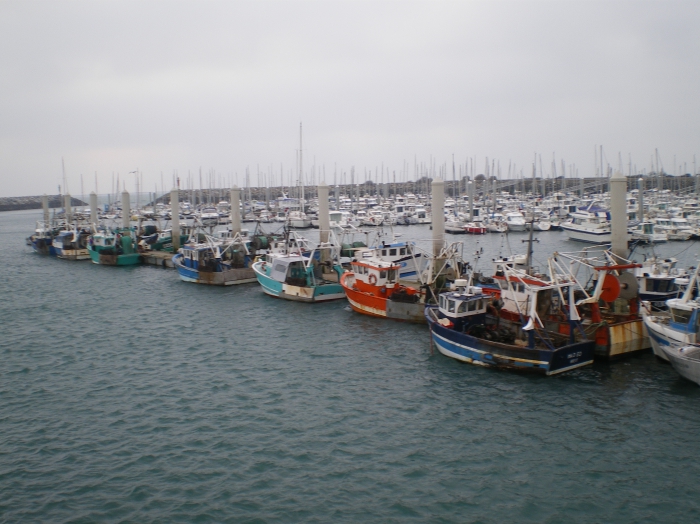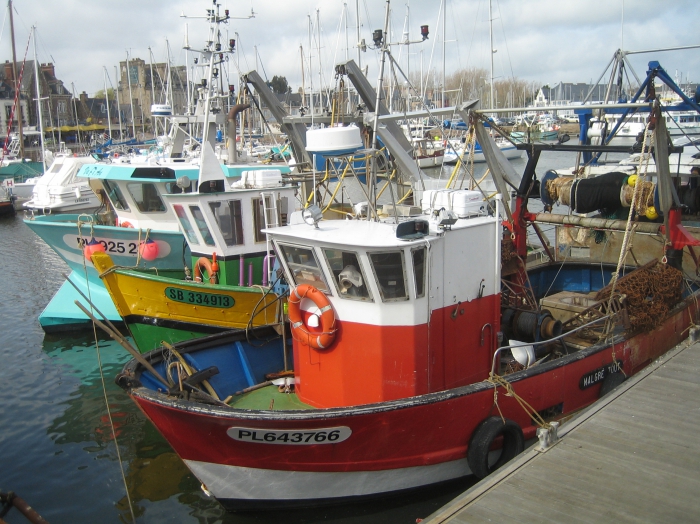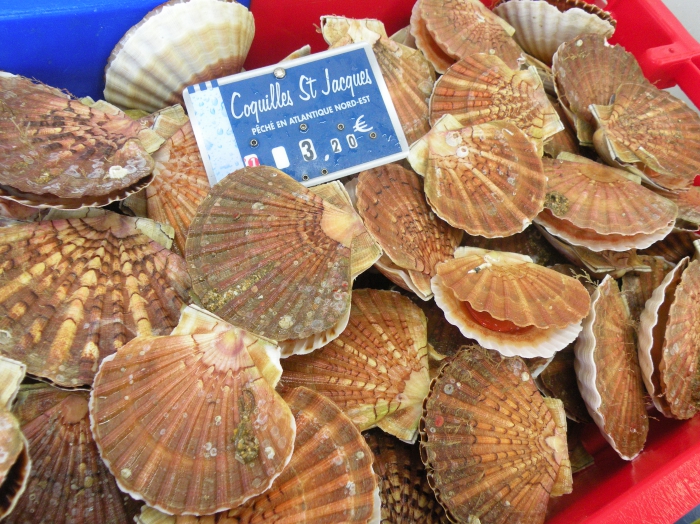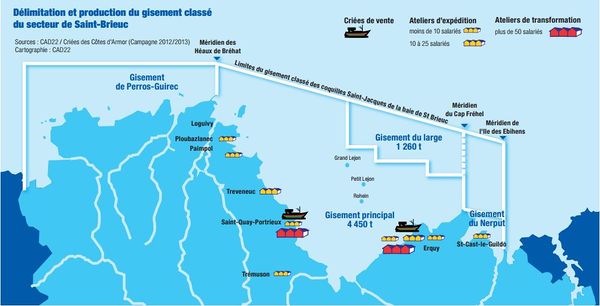Case study Saint Brieuc
Contents
The Great Atlantic scallop fishery of the Saint-Brieuc Bay and its governance (France)
Presentation and history
The Great Atlantic scallop (Pecten maximus) is an emblem of the Bay of Saint-Brieuc where it is nicknamed “white gold” (Figure 1). It is a bivalve found on loose sandy bottoms, generally between 20 and 50 meters depth, and is present in European temperate waters from the Norwegian coastline to northern Spain[1].
- Fig. 1: The Great Atlantic scallop, picture taken in Saint Quay-Portrieux (Source: Agrocampus Ouest).
- Figure 2 : Geographical situation of Saint Brieuc
The Great Atlantic scallop (also referred to as “scallop” in text) is the fourth commercial species in France in terms of value and represents a turnover of 40 million euros[2]. Its exploitation is subject to a strictly regulated fishery, the aim of which is to preserve the stock to maintain this fishery. In the Côtes d’Armor, scallop fishing is a major activity. Indeed, it is the department where the largest deposit in France is located, with about 150 000 ha (Figure 2). Three distinct zones are exploited in the Saint-Brieuc Bay, the main deposit called "of the Bay", the offshore deposit and the Nerput deposit. In this area, scallop exploitation has truly restarted after the decline of the stock of clams in the early 1960s, with the rediscovery of the deposit.
- Fig. 3: Delimitation of the Great Atlantic scallop deposits in the Bay of Saint-Brieuc (Source: CAD 22, 2013[3])
The fishing takes place on a deposit that experiences high interannual variability[4]. Hence, a scientific monitoring by Ifremer has been set up to better understand the stock and adjust fishing effort to the available resource. In addition to this is a regulatory framework, originally established by the professionals, which includes a licensing system to control access to the resource. This fishery is seasonal (approximately from October to April ) so as not to disrupt reproduction, and involves 255 ships for the 2013-2014 campaign. 5 710 tonnes were landed during the 2012-2013 campaign, mainly in the Côtes d’Armor fish markets of Erquy, Saint-Quay Portrieux and Loguivy, generating 10.9 million euros [3]. Ships gather scallops using fishing dredges, the characteristics of which are determined by local regulations (a maximum two dredges on board). Scallops represent the bulk of their annual turnover (up to 40 %), but they often exercise another trade (shellfish dredges, trawls, nets or longlines, crustacean pots) when the season is over[5].


Fig. 4 + 5: The port of Saint-Quay-Portrieux and its dredgers (Source: Agrocampus Ouest, M. Serazin) and the port of Paimpol and its dredgers (Source: Agrocampus Ouest, Henichart).
Organisation of the governance
The Great Atlantic scallop fishery in the Bay of Saint-Brieuc is based on a regulatory system that is managed collectively at the request of the fishermen since the 1970s[6]. It is the first fishery of importance in the English Channel for which a dedicated mechanism was created in order to attempt to limit the number of ships[7]. From the onset, the fishermen have recognised the importance of managing the resource, which resulted in the establishment of a governance based on co-management with the involvement of professionals, scientific support and the collaboration of the authorities in charge of fisheries management. In this system, predominant in France within territorial waters, the resource management initiative originates mainly from these local users. Fishermen are represented here, at the regional level, by the Regional Committee of Maritime Fisheries and Marine Fish Farms (Comité Régional des Pêches Maritimes et des Elevages Marins - CRPMEM) of Brittany, and the Departmental Committees of Maritime Fisheries and Marine Fish Farms (Comités Départementaux des Pêches Maritimes et des Elevages Marins - CDPMEM) at the departmental level. These are occupational institutions. Decision-making is participatory, thus giving stakeholders the opportunity to voice their positions. Fishermen thereby enjoy a degree of autonomy because they hold some control over the management of the fishery[8]. However, the regulatory decision-making falls to the national, or regional administration. The fisheries administration is represented in Brittany by the Interregional Directorate for the Sea Northern Atlantic-Western English Channel (Direction InterRégionale de la Mer Nord Atlantique-Manche Ouest - DIRM NAMO) and the prefect of the region. At the local level (department) is the Departmental Directorate of the Territories and the Sea (Direction Départementale des Territoires et de la Mer - DDTM) and the prefect of the department. The CRPMEM of Brittany is the referent occupational structure for this species at the regional level. It participates, notably, in fisheries management and to the regulation of French territorial waters[9]. Within this committee, the “Shellfish” Commission is the authority dedicated to the management of the scallop fishery in the region. For the Bay of Saint-Brieuc, there is a "Great Atlantic scallop" Commission which is directly linked to the fishermen and the CDPMEM of Côtes d'Armor. Within this commission, local representatives of the fishermen are able to provide advice and suggest, for example, the opening and closing dates of the scallop fishing season, the fishing days and hours, the indicative quotas as well as the date of closing of the fishery when the indicative quota is reached. It allows advice to be fed back and to propose management measures that will be validated by the State at the regional level by the Interregional Directorate for the Sea (Direction Interrégionale de la Mer - DIRM). This is how a system of licenses as well as management measures (such as limiting the number of fishing days for example) were established. The issuance of the licences depends on a set of eligibility criteria as defined by this Commission. On the other hand, in order to satisfactorily manage this fishery, a specific control system was implemented at the request of the fishermen so as to complete the controls of fishing activities by State services. Indeed, the CDPMEM of Côtes d'Armor finances the chartering an airplane in order to carry out aerial surveillance during the fishing periods.
Outlook for the fishery
The Great Atlantic scallop fishery is a collectively managed fishery that has been able to organise itself since 1970 with the creation of the first fishing licenses in France. The governance that has been established is an example of co-management where professionals work together with the administration and scientists.
The surveys conducted within the framework of the GIFS Project[10] allowed to summarise the principal means by which the existing structures contribute to the environmental, socio-cultural and economic sustainability of the fishery.
The environmental dimension, first item of the sustainable development triptych, is one of the pillars of this fishery and its governance. The fishermen have implemented a management on the basis of the availability of the resource, notably through the recommendation of an annual quota which is calculated from an assessment of the stock of scallops carried out prior to the start of each fishing season. Various scientific projects conducted with Ifremer help improve the knowledge of the resource. This scientific approach is an integral part of fisheries management. The socio-cultural aspect, another key element of sustainable development, is present within the fishing community and is underlined by the existence of a healthy working environment with many interactions with other sectors, other communities. There is a strong will from fishermen to develop the economy of their trade by advertising the fact that this fishery is managed in a reasoned manner and that the products are of a high quality. The means used by the fishermen community are, for example, fish market visits for tourists and schools or the staging of festivals allowing them to communicate on the trade and the species. Finally, the economic dimension is an unavoidable aspect of the sustainable development triptych for fishing businesses that exploit this resource. The management of the scallop resource is highly supervised in the Bay of Saint-Brieuc and allows fishermen to have access to the resource each year. However, its marketing is difficult[11]: the market is very competitive in France (competition with other species, foreign competition) and the selling price of the Great Atlantic scallop is quite low when compared to other deposits. Approaches to enhance the value of the scallop were implemented to increase the selling price, and thereby enable a more efficient exploitation of the resource. For example, a collective mark was created for the Great Atlantic scallop, which highlights the quality of the product. More occasional initiatives, such as direct sales, are very present within this fishermen community, which allows an increase of the selling price. A specific marketing system was also set up with the producer organisation as well as an industrialist, to produce frozen scallops so as to segment the market and provide commercial outlets when demand decreases.
These different dimensions of sustainable development are an integral part of the governance of this fishery. Members of the fishermen community and various associated stakeholders are attempting to secure the future of the fleet through co-management. This governance allows fishermen to benefit from regulations that are pertinent to their needs while enabling the sustainability of the fishery. Despite all this and according to the survey respondents, there are some limitations to this governance.
- At the fishery level
The management system that was established for the Great Atlantic scallop, notably the regulation, may encourage fishermen to take more risks. This fishery is known to be especially dangerous because, in particular, of the limitation in fishing time and the large number of vessels on site. Although regulations arose from the fishermen, compliance is not always forthcoming. There is therefore a significant monitoring system in place emanating from the administration as well as the fishermen themselves. Another consequence of this strict management system is the non-correspondence between supply and demand. Indeed, the limitation imposed on fishing days and the prohibition of catches during the summer create a concentration in time of the landings of scallops, thereby triggering a drop in prices.
- At the national and European level
This coastal fishery and its representatives, despite being well up on the policies of Côtes d'Armor, are struggling to make their voice heard at the national as well as European level. They feel that inshore fishing is not sufficiently supported. Yet, even if the fishery is managed at the local level, it is forced to comply with the regulatory constraints of the European Union, in particular through the Common Fisheries Policy (CFP). In addition, fishermen operate in a space where uses are increasingly diversified and where conflicts of use are multiplying. As a result, they fear a loss of support from political bodies in favour of other sectors.
References
- ↑ IFREMER, 2010. Coquille Saint-Jacques de l’Atlantique. Biology of scalops, 1 p.
- ↑ FRANCEAGRIMER, 2013. Les chiffres clés de la filière pêche et aquaculture en France. Edition 2013. Etablissement national des produits de l’agriculture et de la mer, 36 p. Page consulted March 24, 2014.
- ↑ 3.0 3.1 La Coquille Saint-Jacques du gisement naturel classé de la baie de St-Brieuc. Report of Côtes-d’Armor Développement, 2 p. Page consulted October 13, 2013
- ↑ LAUBIER L., 2003. Exploitation et surexploitation des ressources marines vivantes. Académie des Sciences. Report on science and technology n°17. Londres, Paris, Lavoisier, 503 p.
- ↑ MACHER C., MERZEREAUD M., LE GRAND C., FRESARD M., BERTIGNAC M., FIFAS S., GUYADER O. BIAIS G., LISSARDY M., JADAUD A., LE CORRE G., FRANGOUDES K., DAURES F., VAN ISEGHEM, S., RAVEAU A., 2011. Groupe de travail Partenarial pour la construction d’outils bio-économiques d’aide à la décision pour l’aménagement des pêcheries, Publications électroniques Amure, Série Rapports R-21-2011, 44 p. Page consulted December 9, 2013.
- ↑ LESUEUR M., RONCIN N., LE GALLIC B., ROPARS-COLLET C., 2009. La pêche de la Coquille Saint-Jacques en baie de Saint-Brieuc : description de la pêcherie et des systèmes de gestion et de contrôle. Publication AMURE, Série Rapport, 35 p. Page consulted December 13, 2013.
- ↑ MEURIOT E., COCHET Y., FIFAS S., FOUCHER E., GATES J., 1987. Licence de pêche et gestion d'une pêcherie : analyse bio économique de la pêcherie de Coquilles Saint-Jacques en baie de Saint-Brieuc. Economic and juridic report of Ifremer n°4, 70 p.
- ↑ FERRACCI F., 2011. Présentation et analyse d'une cogestion de la ressource halieutique au sein d'une aire marine protégée. Exemple de la réserve naturelle des bouches de Bonifacio. Document presented to get a master degree in environment and master in management of environment and sustainable development, 45 p.. Page consulted February 15, 2014.
- ↑ Loi n°2010-874 du 27 juillet 2010 de modernisation de l’agriculture et de la pêche – LMAP – JORF du 28 juillet 2010, pages 3 à 90
- ↑ PICAULT D., LESUEUR M. 2014. Pêche côtière et gouvernance en France. Rapport d'étude. Axe 1 du projet GIFS. Publications of the AGROCAMPUS OUEST Fisheries and Aquatic Sciences Center n°20 p 86
- ↑ LE GALLIC B., FOURNIER N. (2013). Relations entre systèmes de gestion et stratégies de valorisation. Project report for the projet ANR-COMANCHE, p. 25


